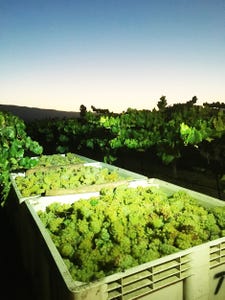

Pedro Castro, celebrating his 20th year as a member of the Trefethen vineyard team, sorts Cabernet Sauvignon in the field. Photos by Jon Ruel
Pedro Castro, celebrating his 20th year as a member of the Trefethen vineyard team, sorts Cabernet Sauvignon in the field. Photos by Jon RuelIt was a busy harvest spanning a 2.5-month period with just enough time for crews to catch their breath after picking one variety before moving onto the next. By the third week of October, all the grapes from the 2016 crop were off the vine in Trefethen Family Vineyards’ fields at the southern end of the Napa Valley.
Jon Ruel is CEO of this Oak Knoll District vineyard and winery which also grows eight other varieties on the valley floor – Chardonnay, Merlot, Riesling, Pinot Noir, Cabernet Franc, Malbec, Petit Verdot and Sauvignon Blanc.
In his 13 years of growing wine grapes, this past season was unlike any other he can remember – and not just because the harvest started unusually early when crews began picking the first Pinot Noir grapes for the lower-sugar sparkling wines.
Their vines began the annual regrowth very early this year, aided by the return of normal amounts of rainfall after several years of drought. Starting in December, the rains continued into April, filling soil profiles.

Trefethen vineyard crew picking Cabernet Franc in their Hillspring vineyard on Sept. 19th. Photos by Jon Ruel
Trefethen vineyard crew picking Cabernet Franc in their Hillspring vineyard on Sept. 19th. Photos by Jon Ruel“Both April and May were warmer than average, so the vines got off to a roaring start,” Ruel says. “Bud break was as much as three weeks early. The vines were happy and grew strongly throughout the season. Managing that growth was a challenge, labor-wise, but we were able to keep up with it.”
Following June, which was warmer than in 2015, crop development slowed. July and August were cooler than usual. The weather included foggy mornings and sunny afternoons with temperatures in the low 80s along with a few hot days but no heat spells.
Then, in September, thermometer readings rose. Their weather stations recorded more 90-degree-plus days that month than during the previous two months combined.
“The limited sunshine and heat in July and August held sugars at reasonable levels, resulting in very long hang time this year,” Ruel says. “By the time we got some heat in September and the sugars rose, the character in the grapes was fantastic. We ended up with ripe fruit, balanced chemistry and moderate alcohol levels. I’m really excited about this vintage, across the board.”

The sun rises over Chardonnay grapes picked in the cool early morning hours at Trefethen. Photos by Jon Ruel
The sun rises over Chardonnay grapes picked in the cool early morning hours at Trefethen. Photos by Jon RuelThat includes his Riesling, a very heat-sensitive variety. It fared much better this year than in 2010, when Trefethen lost 40 percent of their Riesling crop to sunburn damage.
Last year, Trefethen’s wine grape production was a little on the light side in most varieties. This year, yields, overall, were about average, although Chardonnay, Malbec and Pinot Noir were somewhat higher, Ruel notes.
“Those three varieties produced big clusters and big berries this year,” he says. “We thinned the Malbec to just one cluster per shoot and still harvested a very good yield. That’s how big the clusters were.”
Another unusual feature of the 2016 season was the rapid pace of the harvesting work, with few, if any, of the typical breaks in the action between varieties. In one 10-week period and not counting Sundays, his crews were picking grapes on all but five of the 60 possible work days.
“Given our good-size crop, scheduling the field and winery work to keep the harvest moving was a challenge,” he admits. “At times, we came close to running out of tank space but we were able to avoid any bottlenecks.”

Trefethen crew harvesting Cabernet Sauvignon as the sun rises across the Napa Valley. Photos by Jon Ruel
Trefethen crew harvesting Cabernet Sauvignon as the sun rises across the Napa Valley. Photos by Jon RuelIn Napa Valley, where the majority of wineries continue to prefer hand-picked grapes over those harvested with machines, the shrinking supply of workers to harvest the crop remains a key concern for the industry.
Like other growers here, Trefethen seeks to attract and keep good employees, offering year-round work, good wages and full benefits, Ruel notes.
To help meet the quality standards for their wines, Trefethen sorts the harvested grapes in the field.
“While some of the crew is picking the grapes, others are stationed at the macro bins, removing shot berries, leaves and other plant debris,” Ruel says. “This is the only way we can deliver just the type of grapes we want.”
About the Author(s)
You May Also Like




